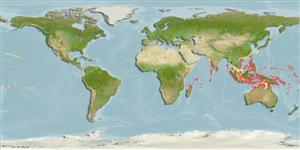>
Gobiiformes (Gobies) >
Gobiidae (Gobies) > Gobiinae
Etymology: Callogobius: Greek, kalos, kallos = beautiful + Latin, gobius = gudgeon (Ref. 45335); maculipinnis: Named for Dr. Richard Van Cleve, then Acting Director of the University of Washington School of Fisheries..
More on author: Fowler.
Issue
Junior synonym Intonsagobius vanclevei is valid according to Delventhal & Mooi, 2013 (Ref. 93174:156 as Callogobius vanclevei).
Environment: milieu / climate zone / depth range / distribution range
Ecologia
marinhas associadas(os) a recifes; intervalo de profundidade 3 - 37 m (Ref. 86942). Tropical; 30°N - 15°S
Indo-Pacific: Red Sea south to Bazaruto (Ref. 2798) and eastward to Samoa; north to the Ryukyu Is., the Philippines, Guam and the Marshall Islands.
Tamanho / Peso / Idade
Maturity: Lm ? range ? - ? cm
Max length : 6.8 cm TL macho/indeterminado; (Ref. 2798)
Descrição breve
Chaves de identificação | Morfologia | Morfometria
Espinhos dorsais (total) : 7; Raios dorsais moles (total) : 9; Espinhos anais: 1; Raios anais moles: 7. Characterized by brown or yellowish brown with scattered pale brown spots on side of body; usually with four diffuse brown bars (below first dorsal, anterior second dorsal, anterior caudal peduncle and on caudal fin base), wavy oblique brown bands on dorsal fins; light and dark spots on all fins except pelvics; dorsal spines tips usually forming short filaments; completely united pelvic fins with well-developed frenum; rounded caudal fin; longitudinal scale series 22-25; cycloid scales on nape, pectoral fin base and breast, becoming ctenoid posteriorly; cheek and opercle with embedded cycloid scales; predorsal scales 6-7; head with prominent papillae ridges; depth of body 4.0 in SL (Ref. 90102).
Occurs among corals.
Life cycle and mating behavior
Maturities | Reprodução | Spawnings | Egg(s) | Fecundities | Larvas
Myers, R.F., 1991. Micronesian reef fishes. Second Ed. Coral Graphics, Barrigada, Guam. 298 p. (Ref. 1602)
Categoria na Lista Vermelha da IUCN (Ref. 130435)
Ameaça para o homem
Harmless
Utilização humana
Ferramentas
Relatórios especiais
Descarregue XML
Fontes da internet
Estimates based on models
Preferred temperature (Ref.
123201): 26.9 - 29, mean 28.1 °C (based on 438 cells).
Phylogenetic diversity index (Ref.
82804): PD
50 = 0.5000 [Uniqueness, from 0.5 = low to 2.0 = high].
Bayesian length-weight: a=0.00708 (0.00333 - 0.01504), b=3.09 (2.92 - 3.26), in cm total length, based on LWR estimates for this (Sub)family-body shape (Ref.
93245).
Nível Trófico (Ref.
69278): 3.2 ±0.3 se; based on size and trophs of closest relatives
Resiliência (Ref.
120179): Elevada, tempo mínimo de duplicação da população menor que 15 meses (Preliminary K or Fecundity.).
Fishing Vulnerability (Ref.
59153): Low vulnerability (10 of 100).
Nutrients (Ref.
124155): Calcium = 184 [81, 378] mg/100g; Iron = 0.923 [0.449, 1.819] mg/100g; Protein = 17.9 [15.9, 19.6] %; Omega3 = 0.101 [0.043, 0.201] g/100g; Selenium = 27.2 [12.0, 64.9] μg/100g; VitaminA = 124 [32, 452] μg/100g; Zinc = 2.37 [1.50, 3.57] mg/100g (wet weight);
